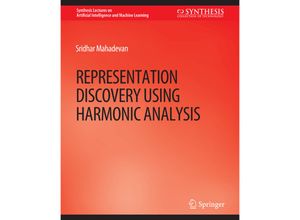Representations are at the heart of artificial intelligence (AI). This book is devoted to the
problem of representation discovery: how can an intelligent system construct representations
from its experience? Representation discovery re-parameterizes the state space - prior to the
application of information retrieval machine learning or optimization techniques -
facilitating later inference processes by constructing new task-specific bases adapted to the
state space geometry. This book presents a general approach to representation discovery using
the framework of harmonic analysis in particular Fourier and wavelet analysis. Biometric
compression methods the compact disc the computerized axial tomography (CAT) scanner in
medicine JPEG compression and spectral analysis of time-series data are among the many
applications of classical Fourier and wavelet analysis. A central goal of this book is to show
that these analytical tools can be generalized from their usual setting in
(infinite-dimensional) Euclidean spaces to discrete (finite-dimensional) spaces typically
studied in many subfields of AI. Generalizing harmonic analysis to discrete spaces poses many
challenges: a discrete representation of the space must be adaptively acquired basis functions
are not pre-defined but rather must be constructed. Algorithms for efficiently computing and
representing bases require dealing with the curse of dimensionality. However the benefits can
outweigh the costs since the extracted basis functions outperform parametric bases as they
often reflect the irregular shape of a particular state space. Case studies from computer
graphics information retrieval machine learning and state space planning are used to
illustrate the benefits of the proposed framework and the challenges that remain to be
addressed. Representation discovery is an actively developing field and the author hopes this
book will encourage other researchers to explore this exciting area of research. Table of
Contents: Overview Vector Spaces Fourier Bases on Graphs Multiscale Bases on Graphs
Scaling to Large Spaces Case Study: State-Space Planning Case Study: Computer Graphics
Case Study: Natural Language Future Directions

